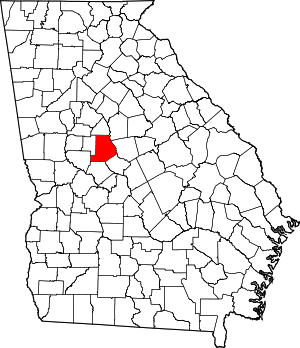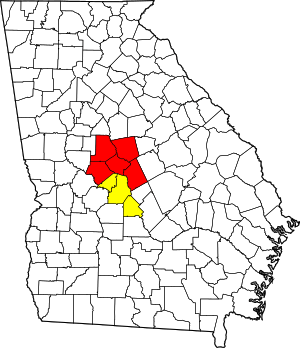Monroe County, Georgia
Monroe County is a county located in the central portion of the U.S. state of Georgia. As of the 2010 census, the population was 26,424.[1] The county seat is Forsyth.[2] The county was created on May 15, 1821.[3] The county was named for James Monroe.[4]
Monroe County | |
|---|---|
 Monroe County courthouse in Forsyth | |
 Location within the U.S. state of Georgia | |
 Georgia's location within the U.S. | |
| Coordinates: 33°01′N 83°55′W | |
| Country | |
| State | |
| Founded | 1826 |
| Seat | Forsyth |
| Largest city | Forsyth |
| Government | |
| • Commission Chair | Greg Tapley |
| Area | |
| • Total | 398 sq mi (1,030 km2) |
| • Land | 396 sq mi (1,030 km2) |
| • Water | 2.2 sq mi (6 km2) 0.5%% |
| Population | |
| • Estimate (2018) | 27,520 |
| • Density | 67/sq mi (26/km2) |
| Time zone | UTC−5 (Eastern) |
| • Summer (DST) | UTC−4 (EDT) |
| Congressional district | 8th |
| Website | www |
Monroe County is included in the Macon, GA Metropolitan Statistical Area.
Geography
According to the U.S. Census Bureau, the county has a total area of 398 square miles (1,030 km2), of which 396 square miles (1,030 km2) is land and 2.2 square miles (5.7 km2) (0.5%) is water.[5] It is located in the Piedmont region of the state.
The vast majority of Monroe County is located in the Upper Ocmulgee River sub-basin of the Altamaha River basin, with just a tiny southwestern corner of the county, west of a line between Yatesville and Culloden, located in the Upper Flint River sub-basin of the ACF River Basin (Apalachicola-Chattahoochee-Flint River Basin).[6]
Major highways














Adjacent counties
- Butts County (north)
- Jasper County (northeast)
- Jones County (east)
- Bibb County (southeast)
- Crawford County (south)
- Upson County (southwest)
- Lamar County (west)
Demographics
| Historical population | |||
|---|---|---|---|
| Census | Pop. | %± | |
| 1830 | 16,202 | — | |
| 1840 | 16,275 | 0.5% | |
| 1850 | 16,985 | 4.4% | |
| 1860 | 15,953 | −6.1% | |
| 1870 | 17,213 | 7.9% | |
| 1880 | 18,808 | 9.3% | |
| 1890 | 19,137 | 1.7% | |
| 1900 | 20,682 | 8.1% | |
| 1910 | 20,450 | −1.1% | |
| 1920 | 20,138 | −1.5% | |
| 1930 | 11,606 | −42.4% | |
| 1940 | 10,749 | −7.4% | |
| 1950 | 10,523 | −2.1% | |
| 1960 | 10,495 | −0.3% | |
| 1970 | 10,991 | 4.7% | |
| 1980 | 14,610 | 32.9% | |
| 1990 | 17,113 | 17.1% | |
| 2000 | 21,757 | 27.1% | |
| 2010 | 26,424 | 21.5% | |
| Est. 2018 | 27,520 | [7] | 4.1% |
| U.S. Decennial Census[8] 1790-1960[9] 1900-1990[10] 1990-2000[11] 2010-2013[1] | |||
2000 census
As of the census[12] of 2000, there were 21,757 people, 7,719 households, and 6,005 families living in the county. The population density was 21/km² (55/mi²). There were 8,425 housing units at an average density of 8/km² (21/mi²). The racial makeup of the county was 70.36% White, 27.93% Black, 0.35% Native American, 0.34% Asian, 0.03% Pacific Islander, 0.25% from other races, and 0.74% from two or more races. 1.29% of the population were Hispanic or Latino of any race.
There were 7,719 households out of which 35.80% had children under the age of 18 living with them, 59.60% were married couples living together, 13.80% had a female householder with no husband present, and 22.20% were non-families. 18.90% of all households were made up of individuals and 7.40% had someone living alone who was 65 years of age or older. The average household size was 2.74 and the average family size was 3.12.
In the county, the population was spread out with 26.30% under the age of 18, 8.30% from 18 to 24, 30.40% from 25 to 44, 24.70% from 45 to 64, and 10.30% who were 65 years of age or older. The median age was 36 years. For every 100 females, there were 99.40 males. For every 100 females age 18 and over, there were 97.20 males.
The median income for a household in the county was $44,195, and the median income for a family was $51,093. Males had a median income of $34,433 versus $22,146 for females. The per capita income for the county was $19,580. About 7.30% of families and 9.80% of the population were below the poverty line, including 12.00% of those under age 18 and 13.30% of those age 65 or over.
2010 census
As of the 2010 United States Census, there were 26,424 people, 9,662 households, and 7,157 families living in the county.[13] The population density was 66.8 inhabitants per square mile (25.8/km2). There were 10,710 housing units at an average density of 27.1 per square mile (10.5/km2).[14] The racial makeup of the county was 73.3% white, 23.7% black or African American, 0.8% Asian, 0.3% American Indian, 0.9% from other races, and 1.0% from two or more races. Those of Hispanic or Latino origin made up 2.0% of the population.[13] In terms of ancestry, 14.7% were American, 13.1% were English, 9.9% were German, and 9.5% were Irish.[15]
Of the 9,662 households, 33.6% had children under the age of 18 living with them, 56.2% were married couples living together, 13.1% had a female householder with no husband present, 25.9% were non-families, and 21.9% of all households were made up of individuals. The average household size was 2.61 and the average family size was 3.03. The median age was 41.3 years.[13]
The median income for a household in the county was $48,297 and the median income for a family was $61,110. Males had a median income of $41,409 versus $32,810 for females. The per capita income for the county was $23,656. About 9.8% of families and 12.3% of the population were below the poverty line, including 15.3% of those under age 18 and 12.9% of those age 65 or over.[16]
Communities
Unincorporated communities
- Berner
- Blount
- Bolingbroke
- Brent
- High Falls
- Juliette
- Moran
- Russellville
- Smarr
- Strouds
Politics
| Year | Republican | Democratic | Third parties |
|---|---|---|---|
| 2016 | 69.6% 8,832 | 28.2% 3,571 | 2.2% 284 |
| 2012 | 68.0% 8,361 | 30.8% 3,785 | 1.2% 149 |
| 2008 | 65.3% 7,933 | 33.8% 4,106 | 0.9% 108 |
| 2004 | 66.6% 6,522 | 32.8% 3,216 | 0.6% 56 |
| 2000 | 60.5% 4,561 | 37.7% 2,839 | 1.9% 141 |
| 1996 | 48.2% 3,054 | 43.7% 2,768 | 8.1% 516 |
| 1992 | 39.3% 2,423 | 45.0% 2,774 | 15.8% 971 |
| 1988 | 56.4% 2,570 | 43.2% 1,970 | 0.4% 18 |
| 1984 | 52.5% 2,420 | 47.5% 2,189 | |
| 1980 | 32.2% 1,242 | 65.9% 2,542 | 2.0% 76 |
| 1976 | 26.7% 1,078 | 73.3% 2,962 | |
| 1972 | 73.4% 2,181 | 26.6% 789 | |
| 1968 | 23.9% 770 | 31.9% 1028 | 44.2% 1,422 |
| 1964 | 51.3% 1,665 | 48.6% 1,578 | 0.0% 1 |
| 1960 | 26.1% 581 | 73.9% 1,642 | |
| 1956 | 24.7% 506 | 75.3% 1,545 | |
| 1952 | 17.2% 501 | 82.8% 2,406 | |
| 1948 | 25.9% 368 | 62.0% 881 | 12.0% 171 |
| 1944 | 26.6% 410 | 73.4% 1,132 | |
| 1940 | 4.6% 49 | 94.9% 1,014 | 0.6% 6 |
| 1936 | 10.3% 147 | 89.2% 1,277 | 0.5% 7 |
| 1932 | 3.6% 45 | 96.3% 1,200 | 0.1% 1 |
| 1928 | 29.1% 329 | 70.9% 801 | |
| 1924 | 8.3% 64 | 87.6% 672 | 4.0% 31 |
| 1920 | 9.0% 83 | 91.0% 837 | |
| 1916 | 7.8% 65 | 86.0% 721 | 6.2% 52 |
| 1912 | 6.5% 50 | 91.2% 702 | 2.3% 18 |
References
- "State & County QuickFacts". United States Census Bureau. Archived from the original on June 7, 2011. Retrieved February 16, 2014.
- "Find a County". National Association of Counties. Retrieved June 7, 2011.
- Krakow, Kenneth K. (1975). Georgia Place-Names: Their History and Origins (PDF). Macon, GA: Winship Press. p. 150. ISBN 0-915430-00-2.
- Gannett, Henry (1905). The Origin of Certain Place Names in the United States. U.S. Government Printing Office. p. 212.
- "US Gazetteer files: 2010, 2000, and 1990". United States Census Bureau. February 12, 2011. Retrieved April 23, 2011.
- "Georgia Soil and Water Conservation Commission Interactive Mapping Experience". Georgia Soil and Water Conservation Commission. Retrieved November 20, 2015.
- "Population and Housing Unit Estimates". Retrieved July 31, 2019.
- "U.S. Decennial Census". United States Census Bureau. Retrieved June 24, 2014.
- "Historical Census Browser". University of Virginia Library. Retrieved June 24, 2014.
- "Population of Counties by Decennial Census: 1900 to 1990". United States Census Bureau. Retrieved June 24, 2014.
- "Census 2000 PHC-T-4. Ranking Tables for Counties: 1990 and 2000" (PDF). United States Census Bureau. Retrieved June 24, 2014.
- "U.S. Census website". United States Census Bureau. Retrieved May 14, 2011.
- "DP-1 Profile of General Population and Housing Characteristics: 2010 Demographic Profile Data". United States Census Bureau. Archived from the original on February 13, 2020. Retrieved December 30, 2015.
- "Population, Housing Units, Area, and Density: 2010 - County". United States Census Bureau. Archived from the original on February 13, 2020. Retrieved December 30, 2015.
- "DP02 SELECTED SOCIAL CHARACTERISTICS IN THE UNITED STATES – 2006-2010 American Community Survey 5-Year Estimates". United States Census Bureau. Archived from the original on February 13, 2020. Retrieved December 30, 2015.
- "DP03 SELECTED ECONOMIC CHARACTERISTICS – 2006-2010 American Community Survey 5-Year Estimates". United States Census Bureau. Archived from the original on February 13, 2020. Retrieved December 30, 2015.
- Leip, David. "Dave Leip's Atlas of U.S. Presidential Elections". uselectionatlas.org. Retrieved March 22, 2018.

